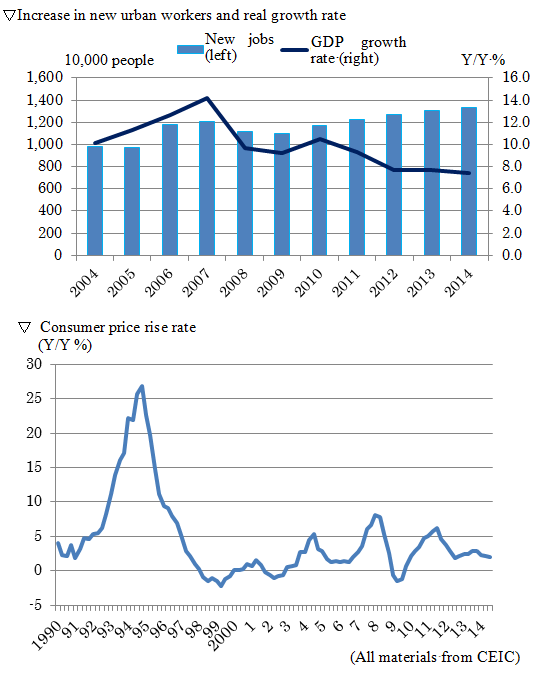Media International Exchange 2014.12.09
Explaining the Wide Belief in Mistaken Pessimism over the Chinese Economy
The Chinese economy has enjoyed stable employment and prices for more than two and a half years now (see figures). This is the first time that China has avoided both inflation and deflation for so long since beginning its transition to market economy back in the 1990s.

Moreover, China's GDP scale caught up with Japan's in 2009, and this year will be more than double. It is expected to continue to grow to triple Japan by 2020 and to surpass the United States by the mid-2020s, positioning China as the world's biggest economic power.
China has already passed its high economic growth peak and is currently in the final stage of that high growth period, transitioning gradually to a stable growth phase. The economic growth rate continues to evince a gentle decline, with the former double-figure growth momentum becoming a thing of the past. However, China remains a major presence in the global economy, sustaining rapid stable growth as the world's second largest economy.
The long-term prospects noted above presume that the Chinese economy will maintain its stability and continue on a solid growth trajectory. With finance platforms and shadow banking recently pumping a huge amount of capital into the economy, there are fears that the formation and eventual collapse of a real estate "mini-bubble" could impact negatively on the financial system, while the structural recession faced by industry as a result of excess capacity is also causing unease.
However, the macroeconomy as a whole is absorbing downward pressure thanks to two powerful engines-the development of the service industry on the back of urbanization, and the formation of industrial clusters through the construction of high-speed rail, expressways and other infrastructure with a strong economic inducement effect. As a result, the economy as a whole has been able to maintain employment and price stability.
Explained in this manner, it is apparent that the Chinese economy is holding a stable trajectory, but many academics, government officials and businesspeople in Japan, the US and Europe have continued to believe pessimistic takes on the Chinese economy ever since the Lehman shock. Every year people continue to predict that next year the economic bubble will collapse, a financial crisis will occur, and the Chinese economy will slow down, and every year those predictions prove to be false. Nevertheless, extreme pessimism over Chinese economic prospects remains deep-rooted even today.
This misapprehension seems to be influenced by two interwoven factors-the difficulty of grasping the entirety of the Chinese economy because of its unique nature, and wishful thinking that would like to see China not develop any further, given its increasingly hardline stance toward other countries.
These factors can be summarized into the following three points.
First, structural change in the Chinese economy is occurring at a pace that outstrips the conventional understanding of businesspeople and economic experts in universities, think tanks and governments in the developed world.
Until around 2004, China struggled unsuccessfully with the structural issue of having hit a balance of payments ceiling, which meant that the trade balance tended to go into deficit during economic expansionary phases. This is an issue faced by many developing countries even now, caused by a lack of export competitiveness.
To overcome this structural flaw, the Chinese government has been attracting the world's top export companies to China since the mid-1990s, using cheap and abundant labor to expand exports from China to the world. The effect of that strategy has manifested clearly since 2005, when the export surplus soared. The Chinese economy was freed from the balance of payments ceiling issue, and started to be able to expand domestic demand and enjoy strong growth without having to worry about balance of trade deterioration. That structural change also saw China realize double-figure growth for five consecutive years from 2003 to 2007, taking the country to the peak of its high growth period.
The average real growth rate for the three years between 2006 and 2008 was 12.2 percent. That in itself is a sufficiently high figure. But, even more surprisingly, the dollar-based nominal growth rate reached an average of 26 percent, doubling China's GDP over three years from US$2.3 trillion in 2005 to US$4.6 trillion in 2008. This rose the next year to US$5.1 trillion, surpassing Japan at US$5.0 trillion.
Comparing 2004 and 2010 as the "bookends" to the tumultuous five years from 2005 to 2009, the average Chinese income almost tripled in six years. Imagining that the average annual income of three-person households in key coastal cities such as Beijing, Shanghai, Guangzhou and Shenzhen rose from 1.5-2.0 million yen (approximately US$15,000-20,000) to 4.5-6.0 million yen (approximately US$45,000-60,000), clearly, standards of living have completely transformed. This change has occurred so rapidly-indeed, at an impossible pace by the lights of the developed world-that it would be no exaggeration to say that China has become an entirely different country.
As a result, cheap labor began to disappear in China as of 2010. At the same time, swift income expansion underpinned the emergence of a massive domestic market with abundant consumer demand. Daily goods of much the same standard as in Japan, the US and Europe in terms of both quality and price began to move regularly off the shelves.
Those who haven't been able to keep pace with this rapid change are bemoaning the loss of cheap and abundant labor, rising production costs and falling profits. However, more competent entrepreneurs have moved quickly since 2005 to shift their production hubs for labor-intensive products to ASEAN and elsewhere, and have enjoyed great success in the Chinese market as high-added-value product sales soar. Successful companies aren't saying much, but companies that have failed blame their failure on the change in the Chinese market-and this is the source of a lot of the misunderstanding.
The second point is the enormous diversity within the Chinese economy.
Because of China's great internal diversity, it defies understanding based on the conventional concept of the nation state. China has a massive population and vast national territory, and in addition to the diversity of climate, language and food culture, there are also unimaginable disparities on the economic front, including the income disparities between rural and urban areas and between general and newly-graduated white collar workers and senior management at major companies, as well as economic development disparities between the coast and the hinterland.
The presence of such major disparities within the country make even consumer price comparisons difficult. There are major differences in the distribution of major consumer product items according to the region, rendering comparisons almost impossible. Economic trends are completely different in the hinterland and along the coast, and between those regions where the booming automobile and electronics industries are clustered and those dependent on the depressed coal and steel industries. Even in the real estate market, policies are still needed to check vigorous real estate demand in places like Beijing, Shanghai, Guangzhou and Shenzhen, but China is dotted with ghost towns in the 3rd and 4th class cities of economically stagnant regions.
Rather than encompassing this diversity, media reports generally zoom in on a single element.
Third, there is the bias of main media in the various countries toward pessimistic views on the Chinese economy.
China's emergence is creating friction with the existing world order in various dimensions. Moreover, because the Chinese government's diplomatic stance has hardened rapidly in the last few years, anti-Chinese sentiment--albeit not as strong as in Japan--is gradually picking up in countries around the world. People in general are therefore more receptive when information is reported that paints China in a poor light.
To boost circulation and program ratings, the media tends to stress negative aspects of China--ghost towns, deteriorating economic indices and environmental destruction, for example--to suit reader and audience tastes. This holds not only for Japan but also the US and Europe. And it's not just the general public that swallows this media information uncritically. Most political scientists, economists, government officials and businesspeople believe the pessimistic picture which the media paints of the Chinese economy quite simply because they don't understand China for the two reasons given above.
When academics, administrators and businesspeople, and even the media itself, view at China through this lens, there is any amount of bad news to find in China's diverse economy. The media then highlights these points in its own reports, and thus China pessimism continues to spiral up and out. This is what has propelled the pessimistic bias of predictions in relation to the Chinese economy ever since the Lehman shock.
The only way to redress this chain of negativity is to wait for people to share a more accurate understanding of the Chinese economy. It has already been four or five years since the Chinese economy achieved its rapid transformation. Hopefully, more understanding of the Chinese economy will gradually develop over the coming years.
